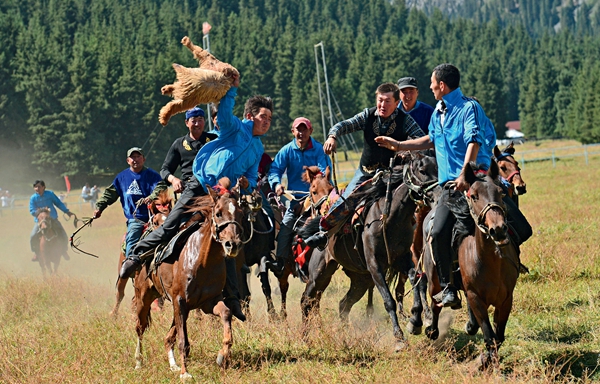Pearl of the Ancient Silk Road
CHINA TODAY,September 04, 2017 Adjust font size:
New Northern Branch of the Ancient Silk Road
Urumqi is Mongolian for“beautiful pasture.” More than 2,000 years ago, the city was a point of strategic importance on the ancient Silk Road on account of its various passageways connecting ancient China with the West. The Silk Road thus constituted not just one but various paths, trodden throughout different historical periods.
One such trail started from the northern slopes of the Kunlun Mountains and led to today’s Iran, and on to the Indian Ocean. It is regarded as the southern branch of the road.

The Tianshan Mountains naturally divide the vast Xinjiang region into two parts.
Another started from the south side of the Tianshan Mountains and crossed the Pamirs to Central Asia and the Persian Gulf. This was the northern branch. Both are on the southern side of Tianshan Mountains. The third path was formed north of Tianshan Mountains during the Western Han Dynasty (202 BC - AD8). It led to various Mediterranean countries, and also became known as the northern branch. Consequently the original northern branch was renamed the central branch.
The section of the northern branch in Xin- jiang was called the new northern branch. It started in Kumul and led via Barkol Lake to Jimusar, Urumqi, Ili, and then westward. The prosperity of the new northern branch was due to its strategic military position. The ruins discovered on the south side of the Wulabo Reservoir in the southeastern suburbs of Urumqi are those of a city that held a key position in military operations in today’s Luntai County, original location of the Protectorate of the Western Regions.
The Tianshan Mountains divide this vast region of Xinjiang into two parts. Prior to the Tang Dynasty (618-907), the central government’s administration and cognition focused on south Xinjiang for many years. As an important supplement to the existing two branches, the new northern branch opened up Xinjiang’s northern inland, so gradually making it a crucial commercial hub that linked oriental culture with that of the civilizations of India and Persia, and also a strategic region throughout history.

A lamb-catching contest is part of the local folk festival.
Established during the reign of Emperor Taizong (598-649) of the Tang Dynasty, Anxi Protectorate had jurisdiction over both north and south Xinjiang, and connected with Persia in the west. Beiting Protectorate was established during the reign of Tang Empress Wu Zetian (624-705). It governed the extensive nomadic areas between the northern Tianshan Mountain and Balkhash Lake in the south, and maintained the solidarity of the Western Regions and safety of Silk Road for some considerable period. A province was established there during the Yuan Dynasty (1271-1368) to strengthen military control over Central Asia.
As a heavily guarded fortress in earlier dynasties, Urumqi was not well developed. Through till 1755 it was little more than a garrison for troops sent by the Qing government to pacify civil strife in Junggar. Large-scale exploitation, in the forms of agriculture, commerce and manufacture, took place for purposes of expanding the population and establishing commercial trade. The ultimate aim was to make Urumqi a city of prosperity and abundance.